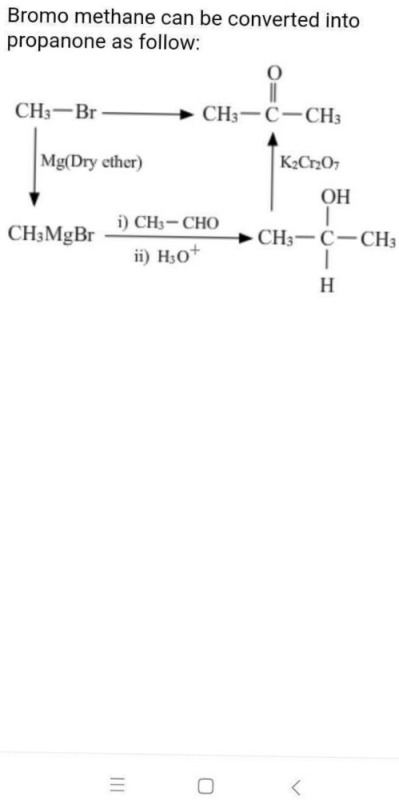JEE Exam > JEE Questions > How to convert bromomethane to propanone ?
Start Learning for Free
How to convert bromomethane to propanone ?
Most Upvoted Answer
How to convert bromomethane to propanone ?
Conversion of Bromomethane to Propanone
Bromomethane can be converted to propanone (also known as acetone) by a multistep process that involves a series of reactions. The overall reaction can be represented as:
CH3Br + 2 KOH + 2 CH3COCH3 → 2 CH3COCH3 + 2 KBr + 2 H2O
Step 1: Preparation of Iodoform
The first step in this process is the preparation of iodoform from bromomethane. This is done by reacting bromomethane with sodium hydroxide (NaOH) and iodine (I2) in the presence of water. The reaction can be represented as:
CH3Br + 3 NaOH + I2 → CHI3 + 3 NaBr + 3 H2O
Iodoform is a yellow solid that has a characteristic smell. It is also known as triiodomethane and is used as an antiseptic and disinfectant.
Step 2: Conversion of Iodoform to Acetone
The next step in the process is the conversion of iodoform to acetone. This is done by reacting iodoform with a strong base such as potassium hydroxide (KOH). The reaction can be represented as:
CHI3 + 4 KOH → KCH3COO + 3 KI + 2 H2O
The product of this reaction is potassium acetate (KCH3COO) and potassium iodide (KI) along with water. The potassium acetate is then acidified with hydrochloric acid (HCl) to produce acetone. The reaction can be represented as:
KCH3COO + HCl → CH3COCH3 + KCl
Acetone is a colorless liquid that has a sweet smell. It is a common solvent used in many industries, including pharmaceuticals, plastics, and cosmetics.
Summary
The conversion of bromomethane to propanone (acetone) involves a multistep process that includes the preparation of iodoform from bromomethane and the conversion of iodoform to acetone using a strong base and acidification. The process can be summarized as:
- Bromomethane + NaOH + I2 → Iodoform
- Iodoform + KOH → Potassium acetate + Potassium iodide + Water
- Potassium acetate + HCl → Acetone + Potassium chloride
Community Answer
How to convert bromomethane to propanone ?


|
Explore Courses for JEE exam
|

|
Similar JEE Doubts
Question Description
How to convert bromomethane to propanone ? for JEE 2025 is part of JEE preparation. The Question and answers have been prepared according to the JEE exam syllabus. Information about How to convert bromomethane to propanone ? covers all topics & solutions for JEE 2025 Exam. Find important definitions, questions, meanings, examples, exercises and tests below for How to convert bromomethane to propanone ?.
How to convert bromomethane to propanone ? for JEE 2025 is part of JEE preparation. The Question and answers have been prepared according to the JEE exam syllabus. Information about How to convert bromomethane to propanone ? covers all topics & solutions for JEE 2025 Exam. Find important definitions, questions, meanings, examples, exercises and tests below for How to convert bromomethane to propanone ?.
Solutions for How to convert bromomethane to propanone ? in English & in Hindi are available as part of our courses for JEE.
Download more important topics, notes, lectures and mock test series for JEE Exam by signing up for free.
Here you can find the meaning of How to convert bromomethane to propanone ? defined & explained in the simplest way possible. Besides giving the explanation of
How to convert bromomethane to propanone ?, a detailed solution for How to convert bromomethane to propanone ? has been provided alongside types of How to convert bromomethane to propanone ? theory, EduRev gives you an
ample number of questions to practice How to convert bromomethane to propanone ? tests, examples and also practice JEE tests.

|
Explore Courses for JEE exam
|

|
Signup to solve all Doubts
Signup to see your scores go up within 7 days! Learn & Practice with 1000+ FREE Notes, Videos & Tests.





















